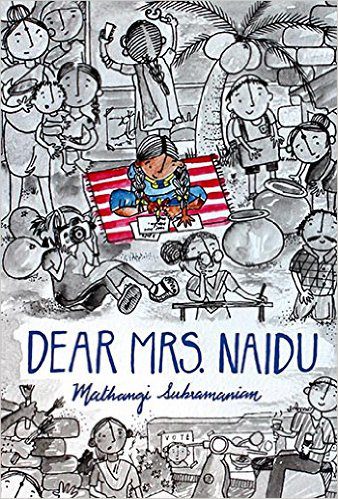 Title: Dear Mrs. Naidu
Title: Dear Mrs. Naidu
Author: Mathangi Subramanian
Publisher: Zubaan Books, 2015
Pages: 286
Genre: Contemporary, Multicultural
Themes: Activism, Friendship, Economic Diversity
Ages: 10 and up
Synopsis (Zubaan Books website):
Twelve-year-old Sarojini’s best friend, Amir, might not be her best friend anymore. Ever since Amir moved out of the slum and started going to a posh private school, it seems like he and Sarojini have nothing in common. Then Sarojini finds out about the Right to Education, a law that might help her get a free seat at Amir’s school – or, better yet, convince him to come back to a new and improved version of the government school they went to together. As she struggles to keep her best friend, Sarojini gets help from some unexpected characters, including Deepti, a feisty classmate who lives at a construction site; Vimala Madam, a human rights lawyer who might also be an evil genius; and Mrs. Sarojini Naidu, a long-dead freedom fighter who becomes Sarojini’s secret pen pal. Told through letters to Mrs. Naidu, this is the story of how Sarojini learns to fight – for her friendship, her family, and her future.
Why I Like This Book:
This book is a window into another world, another lifestyle, one filled with hardship, friendship, and community coming together to improve the education for the lower class students. I love the main character Sarojini, who shows that even a 12-year old, a girl full of heart and courage CAN make a difference.
The story is told in epistolary style. Sarojini is writing letters to a deceased Mrs. Sarojini Naidu as part of a school assignment. Mrs. Sarojini Naidu was an activist and freedom fighter during India’s struggle for independence from the British. As the story unfolds, we see the young Sarojini gain strength. She makes friends with the Deepti the new girl from the construction site, and together they are the heart of the Child Rights Club. Their fight is to make their government school a better place for kids — by advocating for a playground, clean drinking water and more. But gathering support from the community and the local government is a challenge.
I enjoyed the realistic representation of the neighborhood Aunties and the headmaster of Sarojini’s school. While the Aunties initially dissuade the girls and remind them of the dangers of talking to the press, they eventually come to help the Child Rights Club. The headmaster we learn has lost faith in the government from a previously failed attempt, hence the reason he has become jaded.
While this book was published for the Indian audience, I do think there is an audience for this book in the United States. It’s not just for children of Indian ancestry but for any child that is interested in learning about other cultures and what life is like elsewhere. Adults may need to provide some background information on the following topics – fight for Indian independence, slums, government vs private schools in India, views on Hindu-Muslim relations. Short glossary of common words – roti (thin bread), dosa (South Indian rice paper roll), Amma (mother), Appa (father).
Read the Author’s Note to find out the extent of research the author undertook. Impressive.
I highly recommend this book for any middle-school collection.
Find Dear Mrs. Naidu at the following spots:
Kitaab World | Amazon | Barnes & Noble | Goodreads
ISBN-10: 9383074981
ISBN-13: 978-9383074983

Such an interesting story! I agree that there is a broader audience for this book. Thanks for sharing!
Thanks for stopping by. Glad you think there is a wider appeal for this book. 🙂
It is very good